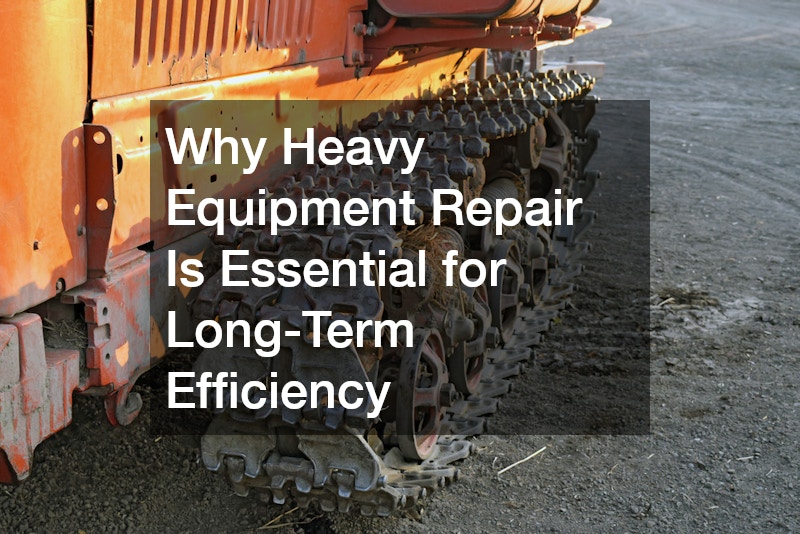Heavy equipment is a backbone of industries like construction, mining, and agriculture, making their maintenance crucial. Proper upkeep prevents unexpected breakdowns, ensuring operational efficiency and effective cost management. Understanding the significance of heavy equipment repair and maintenance can lead to more streamlined operations and improved productivity across various sectors.
How Does Regular Maintenance Impact Equipment Longevity?
Understanding Preventative Maintenance
Preventative maintenance involves routine inspections and services to prevent malfunctions. This proactive approach reduces the risk of major failures, effectively extending the lifespan of heavy machinery.
By investing in regular maintenance, companies can ensure optimal performance, reducing long-term operational costs.
Scheduled maintenance allows for addressing minor issues before they escalate, preserving equipment integrity. Regular checks and servicing can identify wear and potential failures early on. Incorporating these scheduled routines contributes significantly to reducing unexpected expenses related to equipment failures.
Additionally, preventative maintenance improves the safety for operators. Equipment failures can be catastrophic, leading to accidents and injuries. By maintaining equipment proactively, industries not only protect their investments but also their workforce.
Signs of Wear and Tear
Identifying signs of wear and tear early can prevent costly repairs. Common indicators include strange noises, reduced performance, and fluid leaks. Being vigilant about these symptoms ensures timely interventions, preserving the equipment’s functionality.
Operators should be trained to recognize these signs as a part of regular maintenance checks. Early detection and repair prevent minor issues from leading to significant breakdowns. This vigilance is critical in avoiding downtime and ensuring continuous productivity.
Moreover, documenting these signs and repairs helps in tracking equipment health over time. This historical data can inform maintenance schedules and assist in future operational planning. A comprehensive understanding of these indicators fosters a proactive maintenance culture.
Case Studies on Longevity
Real-world cases highlight significant lifespan improvements through regular maintenance. For instance, a construction company reported a 30% increase in equipment life by implementing a rigorous maintenance schedule. This not only prolonged equipment use but also saved substantial costs that might have gone into premature replacements.
Another case study showcases a mining operation that reduced its operational disruptions by 40% through consistent repair interventions. The reliability of their machinery improved, leading to increased productivity and reduced maintenance-related expenses. Such examples illustrate the profound impact that diligent maintenance can have on operational efficiency and equipment durability.
Case studies serve as evidence that maintenance enhances not only equipment lifespan but also company profitability. By learning from these examples, other industries can adopt similar strategies. This proves that investment in maintenance can yield significant returns over time.
What Are the Cost Benefits of Repair Versus Replacement?
Cost Analysis of Repairs
Repairing equipment often presents a more economical option than outright replacement. Initial expenses might seem significant, but they are typically lower than purchasing new equipment. Regular repairs extend the operational life of machinery, spreading the cost over time and enhancing return on investment.
Short-term repair costs might be hefty, but they often represent a fraction of replacement expenses. Long-term benefits include sustained productivity without the disruption of integrating new machinery. This cost-effective approach helps industries manage budgets efficiently while maintaining operational standards.
Moreover, repairs can be scheduled during off-peak hours, minimizing the impact on production. Strategic planning of maintenance activities ensures continued productivity without significant interruptions. The ability to manage repair costs effectively contributes to the overall operational efficiency and financial health of the business.
Evaluating When to Replace
While repairs are generally cost-effective, there are scenarios where replacement becomes necessary. Continual breakdowns, extensive repair costs, or outdated technology may push industries to replace equipment. Evaluating these criteria ensures that companies make informed decisions balancing cost with operational needs.
An analysis of maintenance history and ongoing repair frequency can guide the replacement decision. When repair costs outweigh benefits, replacements become the logical choice. Deciding between repair and replacement requires a thorough assessment of long-term business goals and equipment performance.
Replacing equipment may involve significant upfront costs but could result in better efficiency and reduced long-term operational expenses. New machinery often offers enhanced features, improved technology, and better efficiency. Careful evaluation between upgrading technology and repairing old equipment is essential for sustained productivity and cost management.
Repair and maintenance of heavy equipment are paramount for ensuring long-term efficiency and cost-effectiveness. Regular maintenance not only extends equipment longevity but also optimizes operational productivity by minimizing downtime. By strategically managing the repair and replacement decisions, industries can safeguard their investments, improve safety, and enhance their operational capabilities over time.
.



